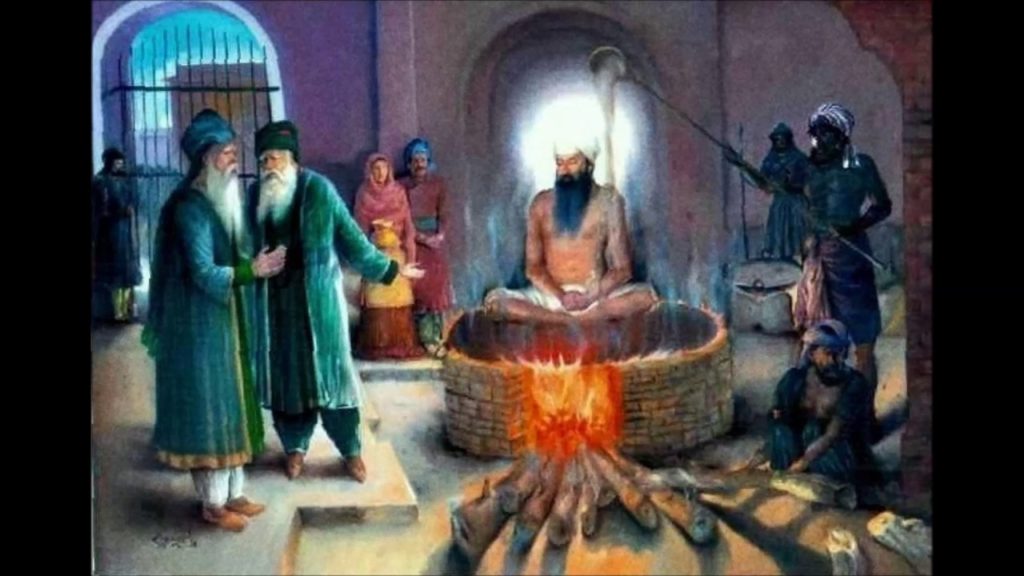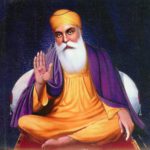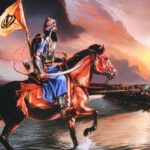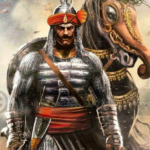
Background
The Fifth Guru of the Sikhs was in many ways an inflection point. If Guru Naanak was the first Sant, and Guru Hargobind was the first of the Sant-Sipaahis, then it was Guru Arjan Dev ji who authorised the militarisation of the Panth. It was he who first took ahimsa (non-violence) to its limits, and showed by example, why exactly that when all peaceful measures had failed, it was right to take up arms in defence of the Dharam.
Arjan Mal was born in the Punjabi Khatri Sodhi family of Guru Ram Das ji. His birth took place at Goindwal on April 15th, 1563. The fourth Guru of the Sikhs had 3 sons. While they were all considered for the Guru Gaddi, they were not all spiritually inclined.
Materialism often creeps up even in the spiritual realm, and the Guru’s eldest son Prithi Chand (Pirthia) was driven more by the exercise of power than the pure, uncovetous calm of spirituality. The middle son Mahadev was a recluse. Therefore, while Pirthia would assist his father in administration of Sikh Sangat, the true spirit of Pangat was found in the youngest son, Arjan. [3, 60]
“Guruship was not a matter of managing funds donated by devotees or excavating tanks to be consecrated for baths. It was concerned primarily with ridding the disciples in the Master’s fold of the shack-les of moh and maya and leading them to salvation through clean living and one-pointed meditation.” [3, 1]
He became Guru on September 1st, 1581, at the young age of 18. Guru Arjan Dev would preside over a momentous period in the Panth. Not only would the Adi Granth be compiled during this time, but the Harmandir Sahib (Golden Temple of Amritsar) would have its groundbreaking ceremony at this time. [1, 61]
So great was Pirthia’s jealousy and ire, that when his youngest brother was anointed Guru, the eldest began misappropriating the funds of Guru Gaddi. He occupied all establishments, leaving Guru Arjan to live in poverty with his family. Not only that, Pirthia had his son Meherban (Manohar Das) compose rival hymns to compete with Guru Arjan. This resulted in corrupting of Gurbaani. Correcting this corruption would be the first of the tremendous contributions of Guru Arjan Dev. [3, 5]
Since the time of Guru Naanak, Sikh Gurus had been composing verses known as Gurbaani. To these were added the words of Sikh Bhagats like Kabir. The elder son of Guru Amar Das was tasked with preserving the collection. Mohan was the maternal uncle of Guru Arjan, and thus, felt humiliated when the latter had been anointed Guru. He shut himself up, along with the Shabads of the Gurus. A number of emissaries were sent to beseech him to part with them, but to no avail.
Finally, Guru Arjan himself went with all humility, and convinced him to part with the collection. This would be known as the Mohan pothi and would be the basis for the Adi Granth — the first edition of the Holy Text of the Sikhs. Contributions would come from all castes and creeds, and from all regions (North and South). The 19 bhagats (bards) whose writings were included along side the shabads of the Guru, were Hindu (17) along with 2 Muslims. They were from regions as distant as Oudh (Bhikan), Rajasthan (Dhanna), Bengal (Jayadeva) and Maharashtra (Namdev). Contributions came even from Varanasi.
“The Granth Sahib started with hymns constituting usual morning, evening and late evening prayers (‘Japuji’, ‘Rahras’, ‘Kirtan Sohila’) respectively and ended with ‘Mundaavnee’, a sort of seal meant to fore-close un-authorized additions to the scripture.” [3, 5]
Bhai Gurdas was the accomplished scholar tasked with organising the Mohanpothis. He mastered Punjabi, Hindi, Sanskrit, and Persian. This original Pothi Sahib is stamped by Guru Arjan Dev and rests at a Gurdwara in Kartarpur, which is in Jalandhar District. Following this monumental work, he wrote the Varan of Bhai Gurdas, which is considered the key to the Sikh Granth. [1, 71]

Guru Arjan’s most visible contribution was laying the groundwork for the Sikh Golden Temple at Amritsar, known as Harmandir Sahib. Guru Ram Das had established a small tank for the benefit of the Panth. Digging began in 1577 CE, and it was known as Ram Das Sar (Sarovar). This was then expanded upon by the Fifth Guru, who then brick-lined it, and constructed a temple in the middle of it.
Guru Arjan Dev reified Sikh Dharma as the teesarpanth. It was the third path that, as per Guru Naanak, was neither Hindu nor Muslim. As a result, the temple was to be neither along Hindu or Muslim architectural lines. Therefore, the Harmandir was constructed in the middle of the tank, with entrances facing all directions.
“There was to be no idol or image to serve as the object of worship in the temple because the Guru believed only in One Attribute less Supreme Being.” [3, 7]
All this soon attracted the attention of all the wrong people. Sulhi Khan was an officer of the mughal ruler. He attacked Guru Arjan on the pretext of revenue collection. The Guru shifted his residence to Wadali as a result. Some time after, Akbar would demand that the Adi Granth be examined for blasphemy against his faith. The Guru sent the Granth along with Bhai Budha and Bhai Gurdas, to explain the contents. This swayed Akbar to give the Sikhs a religious exemption.
Guru Arjan Dev’s first wife had passed away when they were newly weds, so he was yet to be blessed with an heir. His second wife, Mata Ganga, was anxious. Though the Fifth Guru was not agitated by material concerns, he permitted her to go to Baba Budha for a blessing so that Guru Arjan and Mata Ganga might finally conceive. He told her to go without any ceremony, and in the manner of a supplicant. Due to this humility, the Saint blessed the couple, and the future Guru Hargobind would be born on June 14th, 1595. [3, 10]
The evil that not only men, but even women are capable of often escapes the eye of saintly people. Prithi Chand’s wife Karmo had bemoaned the fact that with the birth of Hargobind, her son Meherban could no longer enjoy the wealth and influence at the disposal of the Guru Gaddi. She sent a wet nurse in her employ to serve as veritable medieval Puthana. Poison was applied to her nipple, but the infant Hargobind refused to suckle. True to the grace of Waheguru, the poison affected the nurse instead. When she was later tended to and revived, she confessed her guilt and named her employer. [1, 69]
Other assassination attempts were made, first by sending a snake, and when that failed, a cook. But the Sachapatshah and his household remained protected. Despite all these dangers, Guru Arjan Dev never wilted. “Guru Arjan Dev is quire firm in believing that ‘Khuda’ is the support, the refuge, of those who have none else to fall back upon. He, the Benefactor of the Resourceless, is, therefore, the one to be cherished day and night…A few lines later he fondly remembers Sridhar (Vishnu), Mohan (Krishna), the Creator of all, Nirankar, the Bestower of Bliss. He says the man who forsakes Prabhu to offer obeisance elsewhere appears to be beguiled by pernicious sensual cravings.” [3, 23]
Backbiters continued their agenda against Guru Arjan. Beyond Pirthia’s attempt on his life, there was Chandu Lal Khatri, who had initially insulted the Guru as a pauper, then later came to know of the funds and prominence he possessed, and sent a marriage proposal on behalf of his daughter. As this was rejected repeatedly, Chandu Lal’s baseless pride was outraged, and he began using his influence at the mughal Court to take petty revenge (for so slight an alleged “insult”). Birbal Brahmbhatt (also known as Mahesh Das Bhatt), courtier of Akbar also joined the ranks. He had been instigated by Prithi Chand to check the growing influence of Guru Arjan. [1, 65]
Birbal was one of the few converts to Akbar’s new religion of Din illahi. He took it upon himself to personally counter the Sikhs, and attempted to collect tax, despite their exemption. Anointed Guru at age 18, Guru Arjan Dev faced the ire of not only his jealous elder brother Prithia, but also Raja Birbal. Not only did the latter seek to curtail Sikh influence, but he attempted to re-institute jizya on the previously exempted Sikhs. When he tried to collect various levies on Amritsar, the denizen refused to pay. He even threatened to raze their houses to the ground. Nevertheless, Birbal died in a rebellion at the Swat valley before he could carry out his threats. [1, 66]
However, during the reign of Jahangir, the influence of Guru Arjan had become widespread. Many fanatic clerics in the mughal court began railing against the Sikh “unbelievers”. One such cleric also mentioned that Jahangir’s rebellious son Khusro had been blessed by Guru Arjan and given some small some of money. The jealous Jahangir could not bear this, and so demanded that the Fifth Guru be brought to his court for trial on account of Blasphemy.
“Jahangir lacked his father Akbar’s regard, more his tolerance, for the feelings of the followers of other religions. A bigoted Muslim, he was overly anxious to win the favour of the orthodox priestly order (ulema)”. [3, 15]

The trial and execution were to be supervised by “his diabolical command in person and it was left to Shaikh Farid Buk-hari, leader of the orthodox Ulema (also referred to as Murta Hussain Khan), the viceroy of Punjab, to carry it out.” [3, 16]
Knowing his end was near, Guru Arjan anointed his son Hargobind as the next Guru and instructed him to militarise the panth to protect the faith, and its adherents. He consoled his wife Mata Ganga, and then resolutely went to Lahore. “After Jahangir had proceeded to Kashmir, Guru Arjan’s torments commenced. He was made to sit on a red hot plate of iron, and burning sand and boiling water was poured on his bare body causing copious excruciating blisters. His agony was unbearable, but the Guru neither groaned nor uttered a sigh.” [3, 16]
However, the great Guru would leave mortal coil on his terms. After enduring countless hours of inhuman torment over 5 days, this indriya-vijayin (one who has conquered senses) requested to take bath before final execution, as he refused to convert.
At 43 years of age, the Fifth Guru was in the prime of life, but embraced the fate of a martyr. He attained veer balidaani (shaheedi) in May 30, 1606, on the banks of the river Ravi, by leaving his body as he bathed (jala mahaasamaadhi). But true to his forgiving nature, he did not wish ill on anyone, and prevent Pirs and Tantriks from willing destruction upon his executors. [1, 78]
“Jaisa baalak bhaaye subhaaee lakh apraadh kamaaway,
Kar updesh jhirkey bahu bhaatee bahur pita gal laaway,
Pichhley augun baksh laye Prabhu aagay maarg paaway. (Rag Sorath, p.624)
(Just as a child carried away by his baser instincts perpetrates innumerable blunders and the father after rebuking him harshly embraces him lovingly in the end and tenders him advice, similarly the Lord writes off his devotee’s past errors and guides him to the right path for the future.)” [3, 23]
The Guru had many enemies, and often his harsh words for hypocrites were deemed as condemnation of an entire class. That was not the case: “The Pandit wielded the power acquired by him over the centuries, cleverly & ruthlessly. Guru Arjan addresses himself to the question, how to identify a ‘Pandit’; and comes out with a clear-cut answer as to who is one ( a pandit) and who is not, in Rag Ramkali (p.887) in the following manner: He is given to reproducing from memory texts like Vedas, dilating on their meanings too, but he has not grasped their essence; his minds lacks poise due to the agitation seething within. His heart is totally alien to the Almighty; no love of the Lord is reflected in the pattern of life lived by him and he does not in the least practice what he preaches with much vehemence. He places before himself the idol of a god, he puts a saffron mark on its forehead, bows at its feet, but the whole proceeding is meant only to please his clientele, to hoodwink unwary folks. He does not put his heart in the said ritual, his mind continues to wander in the ten direc-tions all the time
… A Pandit is, it is explained in the lines that follow, one who has freed himself from Maaya, as manifest in its three attributes; one who has come to realise that the Lord’s Name contains all the merit sought to be attained from the perusal of the Vedas and one who accordingly devotes himself to the practice of the Word (Name)” [3, 65]
Achievements

- Contributed 2312 shabads in 30 Ragas.
- Completed the first Compilation of Guru Granth Sahib, called Adi Granth
- Shifted centre to Amritsar. Commenced construction of Har Mandir
- Enjoined Daswandh upon Sikhs to contribute tenth of income for Mandir
- Commenced the tank at Tarn Taran, later completed by Jarnail Khushal Singh
- Became a religious martyr due to intrigues of the mughal court
The Fifth Guru’s term proved to be a momentous and productive one. Beyond the compilation of the Adi Granth and the construction of Harmandir, and his own martyrdom, there were administrative reforms . Daswandh was first instituted in his time and the Masands were reorganised to collect it. A tenth of a Sikh’s earnings, if possible, were to go to Guru Gaddi for the benefit of all Sikhs, and for distribution of charity. This made possible the construction of the Golden Temple. He would also establish the tank at and the town of Tarn Taran. This tank would later grow to be larger than the sarovar at Amritsar. [1, 68]
Little known however, was the Guru’s own accomplishment as both a poet and a musician. It is said that Guru Ram Das’ decision to anoint his youngest son as his successor came when the young Arjan’s letters to him emotionally moved him. [3, 86] In it, the budding poet wrote of the pangs of separation between Guru and his Shish (student). What’s more, as Guru, the Fifth presider of the Gaddi would contribute 2312 shabads to Gurbaani. The fact that this would be done in 30 raagas (included raag Telang) would should how accomplished he was in Sangeeta Saastra.
In effect, Guru Arjan Dev ji was an artiste of the first order, and a talented singer in his own right. [3, 79] He spoke of “Parbrahman” and “Khuda” in the same breath and exhorted Sikhs to worship Allakh Niranjan, the Paramatma who created all beings and who is Nirgun (without material characteristics). This is the reason why Guru Arjan Dev did not install any idol at Harmandir Sahib, and preached the worship of the Formless Divine. The Adi Granth was set as the guiding holy text, and Sikhi would become a distinct religious path but an authentic Dharma nevertheless.
The Guru’s aim was to protect the masses from exploitation from unscrupulous elites, who used debt or even ritual to oppress and blind the masses from worship of “Parbrahman”, who is antaryami (within all beings). This message is clear in Sukhmani Sahib, one of his celebrated contributions to Granth. [3, 88]
“Who, by God’s grace, is with humility blessed,
Says Nanak, attains liberation in life
And bliss, beyond it.” [3, 89]
“Guru Arjan Dev accepts no dividing line between man and man drawn with reference to caste determined by birth or otherwise. The Guru, having been enlightened by his Satguru as to the Supreme Lord permeating every being down to his depths realises that no one is his enemy” [3, 23]“Guru Arjan’s God may be invisible, inaccessible, un-knowable and yet He is very much committed to looking after His creation. His children wherever they might be….He is present with the souls brought by Him into being, without any distinction of religion, caste, colour, region and possessions. The Guru makes this point beautifully in one of his hymns:”
Sagal banaspati menh baisantar
Sagal doodh menh gheea
Ooch Neech menh jot samaanee
ghat ghat Maadho jeea.
Santoh ghat ghat rahiya samaahiyo,
Pooran poor rahiyo sarab menh
Jal thal Ramaiya aahiyo. (Rag Sorath, p.617)
(Just as fire is present in all kinds of vegetation and butter in all kinds of milk, the light of the Lord manifests itself in high and low. O fellow devotees. He pervades in every heart. He, the Per-fect one, fills all beings; He is there in water as well as lands.)” [3, 220]Legacy

“He believed in Guru Nanak’s teachings in Jap ji that ‘Dharam Khand’ teaches a discipline which leads to higher stages of spiritual life. The teachings of Guru Arjan made the Sikhs fearless, adventurous and God loving. They would pray to God, thank God for his benedictions and live a happy and good life.” [1, 70]He was one of the most tireless of the Gurus, and is remembered for numerous contributions, from supervising compilation of the Adi Granth, to his own numerous shabads added to Gurbani, to establishment of Har Mandir Sahib, to mandating Daswand. In a society that privileges primogeniture (with good reason), Guru Arjan Dev was proof of how that cannot be the only criterion—especially in the case of a Guru. Seniority is fine for kings and padshahs, but for the Sacha Patshah greater criteria was required. While Guru Naanak Dev’s elder son, Baba Srichand, accepted the decision of his father with dignity (though he broke off on his own), Guru Ram Das’ elder Son Pirthia, was not so dignified. He felt an unspiritual entitlement to a spiritual position.
“Guru Arjan gives us a glimpse of people who are doomed to fail:
In form, no doubt, he is of human species,
His deeds, however, match those of a beast.
His days and nights he spends impressing
People, with all that is not true.
His exterior would show he’s a man of God,
Inside he is drenched with Maya’s filth,
Hide which he cannot, try however hard he might,
By appearance he is learned, in meditation immersed,
By ablutions clean,
Inside him lurks the dog of greed..(Gauri Sukhmani, p. 267)” [3, 54]
Spiritual power, unlike political power, cannot be wielded cynically, or for material luxuries. It was why there are no popes in Vedic Dharma. But the Sikh model was not luxurious popery, but the panth of the sant-sipaahi. It is also why Guru Gobind Singh declared Sri Guru Granth Sahib as the final Guru—to prevent the rise of a papacy. “No division on the score of caste finds a place in his dispensations. Guru Arjan Dev states with firm conviction: “Khatri Brahman Sood Vais sabh Ekay Nam taraanath” (Rag Maru, p. 1001) (Same is the Name (word ) which leads to every seeker’s empancipation, irrespective of whether he is a Brahmin, Kshatri, Vaish or Shudra.) [3, 60] “Owing to his birth in a Khatri family, Guru Nanak was taken to be a Hindu but he declared categorically, ‘Neither am I a Hindu nor a Muslim’ and thus refused to recognize the division of mankind on narrow sectarian lines. Kabir, brought up as a weaver, was singularly blunt in challenging the superiority assumed by Brahmins on the score of birth alone.’If you were nurtured by a better womb, why did you not adopt a different route for entering the world?‘Jau toon Brahman Brahmini jaaya
Tau aan baat kaahey naheen aaya (Rag Gauri, p.324)” [3, 18]The 10 Gurus had fulfilled the purpose that began when Guru Naanak Dev ji arose from the waters of the Kali Bein river to say, “Na Hindu, na Musalman”. Guru Arjan Dev ji continued this by asserting Sikhi as the teesarpanth (the third path). Guru Gobind Singhi ji would complete this by establishing the Khalsa, to distance Sikhi from Vedic Dharma, while formalising Sikh Dharma as a distinct but authentic Dharma. It was to stand on its own to reject ritual and murthi (idol) worship for pure spiritual upliftment and worship of nirgun Akaal, the timeless and formless One, who is Paramaatma.
“Guru Arjan believed in one God, one author of the whole creation. According to him all living things were created out of five basic elements, Earth, Water, Fire, Air and Ether, in different combinations” [3, 18]Most famously, Guru Arjan Dev ultimately became a martyr for religious freedom. He was summoned to and tortured at the court of Jahangir. Facing a variety of torments, after the 5th day he requested to bathe. He entered the river, but then never returned. Before he left mortal coil, he sent a message to his son, the soon-to-be Guru Hargobind Singh. The missive said that he should militarise the panth and begin to raise an army for the defence of the Guru Gaddi. This was the beginning of the Sikh rise to power.
“The Name or Word of the Almighty which is had from the Mentor as a gift, Guru Arjan Dev advises, should be contemplated all the time, every moment, because it stays with a man, not only in this world but after death too. It becomes his soul’s inseparable mate and serves as his impregnable shield” [3, 50]Om Sat Sri Akaal
ik-oaNkaar sat naam kartaa purakh nirbha-o nirvair akaal moorat ajoonee saibhaN gur parsaad. One Universal Creator God. The Name Is Truth. Creative Being Personified. No Fear. No Hatred. Image Of The Undying, Beyond Birth, Self-Existent. By Guru’s Grace ~ 1-1 [4]
References:
- Singh, Priti Pal. History of the Sikh Gurus. New Delhi: Lotus Press. 2013
- Grewal, J.S. The Sikhs of the Punjab.Cambridge. 2017
- Joshi, Mohan Singh. Guru Arjan Dev: Makers of Indian Literature. Delhi: Sahitya Akademi.
- Sri Guru Granth Sahib


